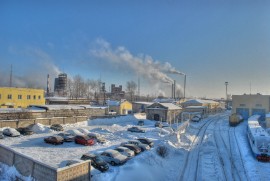Dzerzhinsk, Russia
Pollutant: Numerous chemicals and toxic byproducts from numerous chemical-manufacturing processes
Population Affected: 300,000
Throughout the Soviet period, Dzershinsk was one of Russia’s principle sites of chemical manufacturing, including chemical weapons. Today, it is still a significant center of Russian chemical industry. Between 1930 and 1998, an estimated 300,000 tons of chemical wastes were improperly land filled in Dzershinsk and the surrounding areas. From this waste, around 190 identified chemicals were released into the groundwater. In 2007, water samples taken within the city showed levels of dioxins and phenol thousands of times above recommended levels. This prompted the Guinness Book of World Records to name Dzershinsk the most polluted city in the world later that year. Over the last years, efforts have been undertaken to close down outdated facilities and restore contaminated land.
High concentrations of toxic phenol in the air has led to residents of Dzershinsk suffering from increased levels of diseases and cancers of the eyes, lungs, and kidneys.[1] This has caused life expectancy in the city to plummet. A study from 2006 revealed that average life expectancy in Dzershinsk was 47 for women and just 42 for men.[2] Sulfur dioxide in the air also remains a big problem. A study published in 2013 found that 35% of those residents living adjacent to an industrial or mining area had experienced a chronic cough with sputum, compared to just 18% of those residents who did not (odds ratio: 2.16).[3] The city has a total population of nearly 245,000 people. The toxic emissions and pollutants from local industries are potentially affecting all of the local residents.
[1] Environmental Disaster in Dzerzhinsk, 2011. Available at: http://survincity.com/2011/02/environmental-disaster-in-dzerzhinsk/
[2] Environmental Disaster in Dzerzhinsk, 2011. Available at: http://survincity.com/2011/02/environmental-disaster-in-dzerzhinsk/
[3] Nieminen, P et al. "Environmental Exposure as an Independent Risk Factor of Chronic Bronchitis in Northwest Russia." International Journal of Circumpolar Health 72 (2013).




